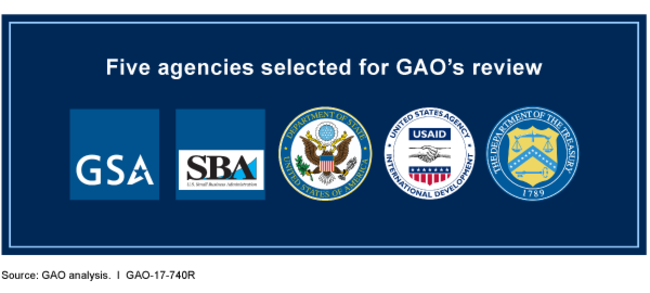Managing for Results: Selected Agencies' Experiences in Implementing Strategic Reviews
Fast Facts
Federal agencies annually assess their progress towards achieving strategic objectives—the specific outcomes or impacts their various programs and efforts aim to accomplish.
We looked at five agencies' experiences conducting these strategic reviews and identified some common themes:
The reviews helped focus leadership attention on objectives needing the most attention
Agencies conducted their reviews as part of their existing management and performance processes, instead of creating new procedures
Agencies captured lessons learned from their reviews, and used them to refine and improve future strategic reviews

Graphic showing the logos of GSA, SBA, State, USAID and Treasury
Highlights
What GAO Found
In implementing the GPRA Modernization Act of 2010 (GPRAMA), the Office of Management and Budget (OMB) established a strategic review process. Beginning in 2014, agencies were to annually assess their progress in achieving each strategic objective—the outcome or impact the agency is intending to achieve—in their strategic plans. Agencies completed their fourth round of strategic reviews in 2017. GAO found that the five selected agencies’ experiences implementing strategic reviews fell into three areas: 1) helping direct leadership attention to progress on strategic objectives, 2) using existing agency management and performance processes to conduct strategic reviews, and 3) refining strategic reviews by capturing lessons learned.
Help Direct Leadership Attention: Strategic reviews helped the selected agencies focus their leadership’s attention, and raise visibility with OMB, on strategic objectives that needed the highest level attention to drive progress. For example, Small Business Administration (SBA) officials stated that during their strategic review discussion with OMB staff, they talked about SBA’s challenges with information technology (IT). These challenges were the key reason SBA categorized its objective to streamline, simplify, and strengthen operations as a focus area for improvement. SBA officials stated that SBA subsequently reprioritized funding for streamlining IT systems, and that the strategic reviews helped provide a platform to elevate IT issues with OMB staff.
Using Existing Management and Performance Processes: The selected agencies conducted strategic reviews as part of existing management and performance processes which they found to be more effective and less burdensome than creating new or separate processes to conduct their reviews. For example, Department of State (State) and U.S. Agency for International Development (USAID) officials told GAO strategic reviews were effective when they leveraged existing performance and management processes. State officials told GAO that their strategic review process was decentralized because State’s bureaus and missions around the world assessed progress against their own strategies. They said they found this existing, decentralized process effective in assessing progress on State’s strategic objectives. USAID officials stated that they routinely reviewed progress on their strategic objectives by using performance evaluations and other sources of evidence. They said they continued with this approach to conduct their strategic reviews.
Capturing Lessons Learned: The selected agencies found it useful to refine their reviews by gathering lessons learned, and by developing maturity models to assess their evolution. For example, Department of Treasury (Treasury) officials completed an “after-action” assessment, and shared lessons learned and planned improvements with all the agency’s leadership and Treasury components. Treasury officials documented the results of this effort and identified best practices for future strategic reviews. Treasury officials said they also developed a maturity model to refine their approach for conducting strategic reviews. For example, the model described how Treasury began the reviews in 2014 by collecting baseline data. This process evolved to the point where the reviews would inform Treasury’s next strategic plan for 2018-2022, according to officials.
Why GAO Did This Study
GPRAMA provides important tools that can help inform federal decision making. GAO is required to review GPRAMA implementation at several critical junctures. As part of GAO’s response to the mandate, this report describes five selected agencies’ experiences in implementing strategic reviews: (1) General Services Administration, (2) Small Business Administration, (3) Department of State, (4) U.S. Agency for International Development; and (5) Department of the Treasury. GAO selected agencies that, in consultation with OMB, identified strategic objectives as either demonstrating noteworthy progress, or focus areas for improvement, during their 2015 strategic reviews. GAO also selected agencies whose strategic review processes had a greater chance of addressing areas of fragmentation, overlap, and duplication, and high-risk issues identified in GAO’s past work. GAO reviewed documents and interviewed officials from the five selected agencies to learn about their experiences with the strategic reviews at their agencies. GAO used this information to develop common themes to describe the selected agencies’ experiences in implementing strategic reviews. GAO also met with OMB staff to discuss OMB’s role and future plans for agency strategic reviews.
GAO is not making any recommendations. OMB and the five selected agencies had no comments on this report.
For more information, contact J. Christopher Mihm at (202) 512-6806 or mihmj@gao.gov.
